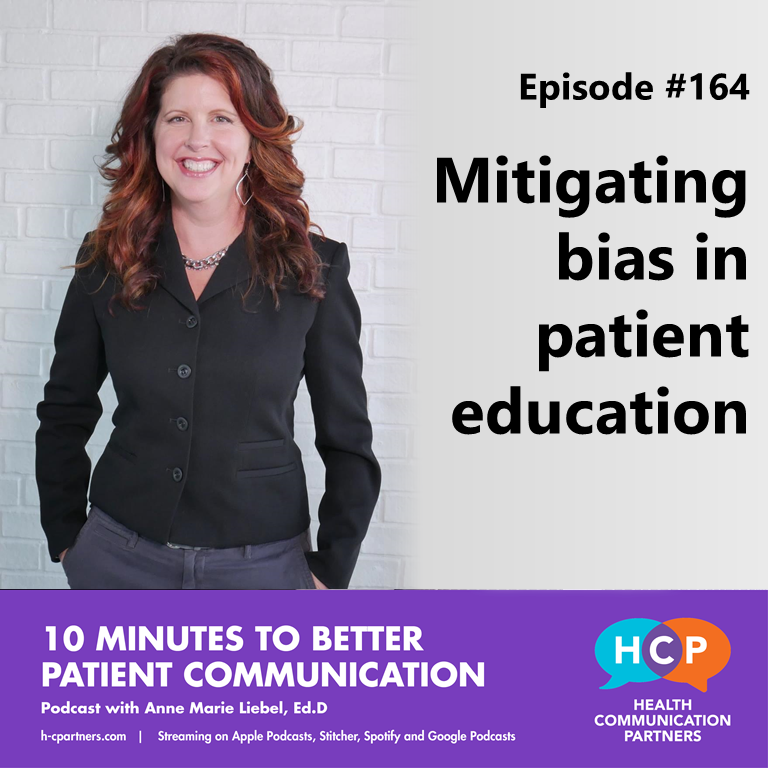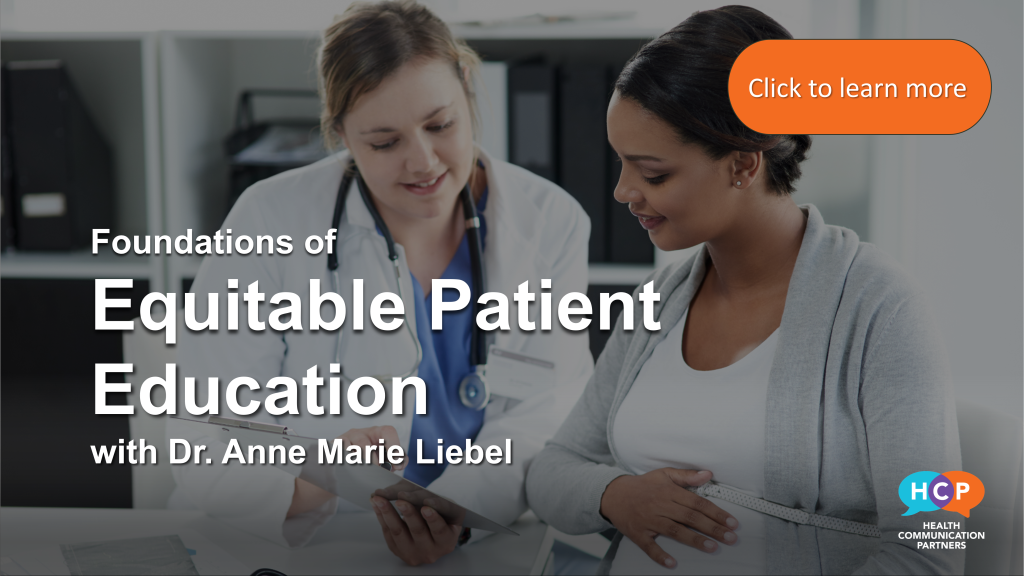Welcome to our new listeners! Here’s some steps you can take today if you’re concerned about how bias can show up in patient education–beyond individual-level biases.

If you’re working hard on patient education, I see you. This episode’s for you. In this episode, I offer some steps you can take today to level up a bit if you’re concerned about bias in patient education.
Hi everybody. This is 10 Minutes to Better Patient Communication from Health Communication Partners. I’m Dr. Anne Marie Liebel. If you’re responsible for quality improvement, patient experience or patient education, you’ll like our course Equitable Patient Education. It’s quick, it’s convenient, it’s accessible, it’s ready to go and the pricing is great. It ticks all the boxes and I made it for you. For more information, visit healthcommunicationpartners .com or find me on LinkedIn.
Speaking of which, finding me on LinkedIn is one of the three ways that you can get in touch with me. And I want to say hi to our new listeners because we have a bunch. This is super exciting! So if you’re new or maybe you’ve been listening for a while but you haven’t reached out in a while, there’s three ways to get in touch with me. Message me on LinkedIn. Visit healthcommunicationpartners.com and click on Contact. or old fashioned email. I’m at Anne Marie A -N -N -E -M -A -R -I -E at h-cpartners .com.
And you may know I was a public school teacher and then a professor of education. I was a professor here in South Carolina at Clemson. And so I’ve long been aware that most teachers look and sound and see the world like me, but many students do not. And as a teacher, I care about all of my kids, so it was hard for me to grapple with the fact that as educators, we do a better job at educating certain children than others.
So as an educator, I have to think deeply about what assumptions I make, and what baggage I brought to the classroom when I was a teacher, what I brought to the university, even what I bring to this show. And it was after I got involved at a research project at Clemson on patient -physician communication that I realized much of what we know about teaching and learning, and how schools structure relationships between teachers and students, also can apply to health care. And that’s why I started Health Communication Partners.
So over the years since then, one of the things I’ve learned about our audience, our listeners, and my clients really: you’re here because you’re a reflective practitioner. You’re already working hard. You care about your jobs, even though you’re rushed and overtaxed. You’re hustling, you care about all of your patients, and you know how much patient education matters to outcomes.
You’re already thinking carefully about how you provide care to each individual person. You’re aware of larger issues in the field. And that’s why you’re here. So one of the things we have in common is that we’re all working to reduce avoidable disparities.
And we know the overall effect of patient education is statistically significant and it’s positive. So we want all patients to benefit from the effectiveness of patient education, right? We’re all aiming for care that’s equitable, that’s patient centered.
And equitable just to refresh, I lean on the quality definition from the Institute of Medicine that includes quality care is equitable, meaning “providing care that does not vary in quality because of personal characteristics such as gender, ethnicity, geographic location, and socioeconomic status.”
One of the delights of being in this position that I’m in is how many people’s education stories I get to hear up close and personal. Compelling, rigorous, thoughtful, patient centered. And I get to hear about your work with trauma informed pedagogies as well, anti -racist pedagogies. Just last month I presented at a conference Anti -racism in Medical Education and I want to give a shout out to that group because it was a wonderful conference.
I also want to give a shout out to my patient experience people in the house, because patient experience is another one of these areas where equity has a direct impact. according to the press gainey people when there’s larger gaps in equity is associated with lower patient experience scores.
I think it’s fair to say we all know that one way to promote quality equitable care is to reduce bias. And I’m going to go out on a limb here and say, you’ve had unconscious bias workshops. I know because I’ve taught some of them. And yes, unconscious bias at an individual level is part of the story here, but there is more to it at the institutional level.
So that’s what I want to talk about now. I want to share with you a way to think about bias and mitigating bias that I hope will be helpful no matter what your role is or what patients you work with. It’ll take a few steps here.
First of all, I’ll ask you to step back, give yourself a moment to get a little bit of perspective on patient education as a process. If we want to get anywhere on this, we’re going to need to reflect, including if we want to mitigate bias in patient education. Let’s make sure we’re supporting ourselves in thinking about the education process as a process.
Not that we’re just going through, but that can be looked at, that can be improved. And I don’t know the last time you got asked to do this. but I’m going to invite you to see your educating as something you can study. something you can get to know better. something you can learn from. Directly.
Now this is a little different than reading journal articles or looking at outside experts. And I think it’s essential to look at other people’s educational processes. It’s crucially valuable to look at research and I’m one of the experts that you’re turning to.
But you matter as more than just an implementer of practices and steps that were developed somewhere else. You matter as a thinker and doer in your own right. So outside research isn’t the only thing worth being familiar with. Our own day -to -day educational processes are worth being curious about, getting up close and personal with.
Not in a judge-y way, not in a kind of scoring or grading ourselves way, if we do or don’t use something, or how well we do or don’t match up to our program, or how close to the plan we were able to stay today. So I’m going to ask you, as step one, give yourself permission to kind of step back, get some perspective on your own educational process.
And number two is to let yourself ask, “What’s happening here? What can I learn by looking closely at my own processes?” And I’ll ask you to keep in mind that how you assess, how you plan, how you implement your plan, how you evaluate, and much more is shaped by our individual choices, yes, and by the contexts we work in.
We’re really well aware of what’s doable, what’s done, and what’s not done where we work. So this is where institutional level pressures, norms, and biases can get in. It might seem counterintuitive to think about educating as a process that could be inequitable for some patients, but decades of research show some educational policies, practices, materials can advantage some people and some social groups. This is beyond individual level bias.
What do I mean by this? Sometimes patients can be framed or positioned in negative ways by research, by theories, by policies, and sometimes just by the everyday taken for granted arrangements where we work. For example, I’ve seen across many, many, many institutions that there are plenty of pressures against, or we could say biases against, thinking about your patients as learners.
In the patient education scenario, there’s huge amounts of pressure on you. You’ve got a plan, you’ve got to get through it. You’re focusing mainly on what you have to do, what you have to say, questions you need to ask, data you need to gather, answers that you need to confirm, form fields you need to fill out, your side of the process in the educator role. And this is completely understandable.
These are institutional level pressures that can turn into biases or blindfolds when it comes to patients. So I’ll ask you to consider these kinds of institutional pressures and what they’re doing to your patient education. There’s many more than this.
The third step is to remember, or let yourself remind yourself, that your patient is a learner who is going through a learning process just as surely as you are going through a teaching process.
Remember to see that patients are learners at a certain spot in that process too, regarding what you’re teaching. These are people with busy lives and a whole lot going on right now, where they are in front of you.
And step four, I’ll invite you to get together with other people who are doing the same thing.
If you want more help here to understand how patient education can unintentionally be inequitable, how the ways we teach can accidentally favor disadvantaged certain patients, and what can be done about it, we have our course on Equitable Patient Education. Visit me at healthcommunicationpartners.com, click on courses. This has been 10 Minutes to Better Patient Communication from Health Communication Partners. Audio Engineering and Music by Joe Liebel. Additional Music by Alexis Rounds.
